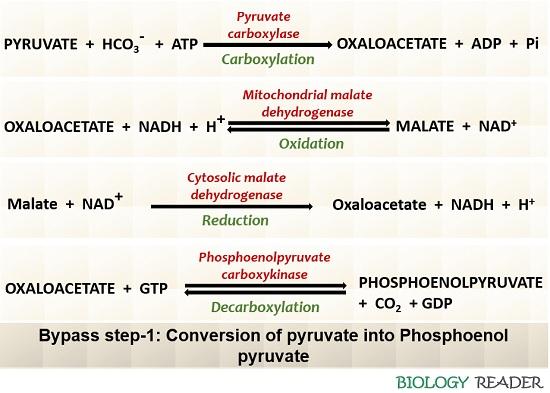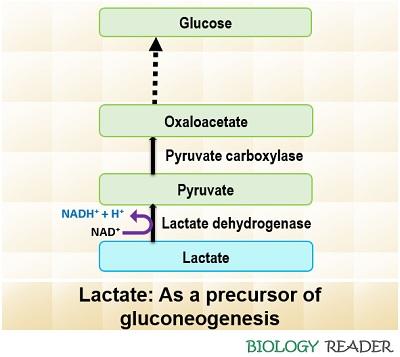Gluconeogenesis occurs in a reverse manner of glycolysis, which produces glucose by the precursors like pyruvate, lactate, glucogenic amino acids. It is sometimes called Neoglucogenesis. It is a ubiquitous or universal pathway, which occurs in humans, animals, plants, fungi and other living organisms.
Gluconeogenesis has only three irreversible steps opposite the glycolysis pathway, while the other seven steps are in common. It includes four reactions that bypass the three irreversible reactions of glycolysis.
We could understand the meaning of gluconeogenesis by breaking the term into gluco, neo and genesis. Now, it is quite easy to remember the meaning of gluconeogenesis, in which gluco means glucose, neo means new, and genesis indicates synthesis. So, don’t get confused with the terms like glycolysis, glycogenesis, glycogenolysis.
In this context, we will discuss the definition, site of occurrence, importance and steps involved in the gluconeogenesis pathway. Also, the substrates initiating the neoglucogenesis pathway is explained along with the gluconeogenesis regulation.
Content: Gluconeogenesis
- Definition
- Where does Gluconeogenesis Occur
- Gluconeogenesis Pathway
- Substrates
- Importance
- Gluconeogenesis Regulation
Gluconeogenesis Definition
GNG is an acronym for the term gluconeogenesis. It refers to the metabolic pathway synthesising new glucose molecules from the non-glucose substrates like lactate and TCA intermediates. Sometimes, gluconeogenesis also refers to the “Endogenous glucose pathway” as it needs energy input.
The small precursor molecules combine to produce a high energy product like glucose. Gluconeogenesis is an important cycle producing glucose, which serves as a “Key metabolite” to carry out all catabolic processes and sustain life.

Where does Gluconeogenesis Occur
The process of neoglucogenesis takes place inside the liver, cortex of the kidney and enterocyte cells of the small intestine. Most of the gluconeogenesis steps occur inside the cytosol than in mitochondria.
Gluconeogenesis Pathway
Gluconeogenesis differs from glycolysis by three irreversible reactions mediated by three different enzymes.
Step-1: Conversion of pyruvate into phosphoenolpyruvate
It is the first reaction that bypasses an irreversible reaction of glycolysis, mediated by pyruvate kinase. The transformation of pyruvate into phosphoenolpyruvate includes two series of steps:

Carboxylation of Pyruvate into Oxaloacetate
Pyruvate carboxylase mediates the transformation of pyruvate to oxaloacetate by adding one carbon dioxide molecule. An enzyme (pyruvate carboxylase) was first discovered in 1960 by a scientist named Merton Utter.
Pyruvate carboxylase is a mitochondrial enzyme that allows the pyruvate present in the cytosol to enter the mitochondrial matrix via an association of MPC-1 and MPC-2 complexes.
The carboxylation of pyruvate into oxaloacetate requires an input of a high energy ATP molecule and the presence of Mg2+ and Mn2+ ions. Pyruvate carboxylation results in the formation of oxaloacetate and one ADP.
Decarboxylation of oxaloacetate into Phosphoenolpyruvate
The transport of oxaloacetate from mitochondria to cytosol does not involve any carrier complexes or transporters. It only occurs by the reduction of oxaloacetate into malate via mitochondrial malate dehydrogenase.
Then, malate moves beyond the inner mitochondrial membrane through the malate aspartate shuttle and malate α-ketoglutarate transporter. In a cytosol, malate reoxidizes into oxaloacetate by an enzyme (cytosolic malate dehydrogenase).
Phosphoenolpyruvate carboxykinase changes oxaloacetate into phosphoenolpyruvate by removing carbon dioxide. It is an isoenzyme present equally in both mitochondria and cytosol.
The decarboxylation of oxaloacetate into phosphoenolpyruvate needs a high energy ATP molecule and the presence of Mg2+ and Mn2+ ions. This reaction is reversible under normal cellular conditions.
Step-2: Dephosphorylation of fructose 1, 6- biphosphate into fructose 6-phosphate
It is a second reaction that bypasses an irreversible reaction of glycolysis, mediated by the enzyme phosphofructokinase. In gluconeogenesis, fructose 1, 6-phosphatase enzyme mediates the dephosphorylation of fructose 1, 6- biphosphate into fructose 6-phosphate and requires Mg2+ ions. An enzyme (fructose 1, 6-phosphatase) causes hydrolysis of C-1 phosphate in the fructose 1, 6- biphosphate molecule, without ATP release.

Step-3: Dephosphorylation of glucose 6-phosphate into glucose
It is a third step, which bypasses an irreversible reaction of glycolysis, catalyzed by an enzyme hexokinase. On the contrary, glucose 6-phosphatase promotes this reaction in a gluconeogenesis cycle and dephosphorylates glucose 6-phosphate into glucose.
Glucose 6-phosphatase is a protein complex that resides within the membrane of the endoplasmic reticulum. It consists of an active catalytic site and a transporter complex.

The active catalytic site mediates the release of glucose in the lumen of the endoplasmic reticulum (not cytosol) by the transporter complex “glucose 6-phosphate translocase or T1”. Glucose 6-phosphatase is dependent on Mg2+ ions that catalyzes the last step.
The glucose molecule formed after dephosphorylation of glucose 6-phosphate is shuttled into the cytoplasm by the glucose transporters of the endoplasmic reticulum.
Substrates
All the intermediates of the glycolysis and tricarboxylic acid cycle provide a substrate for neoglucogenesis. It includes substrates like glycerol, lactate, glucogenic amino acid etc.
Glycerol
It is a product formed due to triglyceride hydrolysis in the adipose tissues and transferred to the liver via blood. Glycerol is an intermediate substrate, which produces glucose solely in the cytosol. It enters the cycle by the two sequential steps:

Glycerol kinase is an enzyme found in both the liver and kidney that undertakes the phosphorylation of glycerol into glycerol 3-phosphate by using ATP.
Then, oxidation of glycerol phosphate into dihydroxyacetone phosphate occurs, as the NAD reduces into NADH. Dihydroxyacetone is an intermediate of the glycolytic pathway.
Lactate
It is a product formed as a result of anaerobic glycolysis in the skeletal muscles and erythrocytes. Lactate is transferred from the muscles to the liver via blood. It reconverts into pyruvate inside the liver and later undertakes the production of glucose through gluconeogenesis.

Glucogenic amino acids
These are derived by the hydrolysis of tissue proteins. Glucogenic acids like α-ketoglutarate, Succinyl Co-A, fumarate, oxaloacetate and fumarate are the only precursors, which can produce glucose. There are two entry points, namely pyruvate and oxaloacetate, through which the glucogenic amino acids can enter the neoglucogenesis cycle.

Importance
- The gluconeogenesis cycle performs a crucial role in blood-glucose homeostasis during starvation.
- The product of neoglucogenesis, i.e. glucose, fulfils the energy demands of many cells and tissues like RBCs, neurons, skeletal muscle, medulla of the kidney, testes, embryonic tissue etc.
- The Neoglucogenesis cycle clears metabolites accumulated in the blood, like lactate (produced from muscles and RBCs) and glycerol (produced from adipose tissue).
Regulation of Gluconeogenesis
The regulation of gluconeogenesis includes the following factors:
Acetyl CoA
It is a kind of reciprocal regulation, which regulates the transformation of pyruvate to PEP. Acetyl Co-A accumulates in the liver as a result of excessive lipolysis in adipose tissues. When acetyl Co-A concentration is higher, it inhibits the glycolytic enzyme phosphate dehydrogenase activity and stimulates the pyruvate carboxylase activity.
Thus, the high level of acetyl Co-A influences the gluconeogenesis cycle. It can regulate the pathway both positively and negatively.
- Positive regulation: Acetyl Co-A promotes the enzymatic activity of the pyruvate carboxylase, which in turn produces more oxaloacetate and end product glucose.
- Negative regulation: Acetyl Co-A inhibits the enzymatic activity of pyruvate dehydrogenase, which converts pyruvate carboxylase to acetyl Co-A.
Glucagon
It is a kind of hormonal regulation secreted from the α-cells of pancreatic islets when the blood glucose level in a body starts decreasing.
Glucagon regulates the conversion of fructose 1, 6-biphosphate to fructose 6-phosphate or favours the process of gluconeogenesis by the following two mechanisms:
- Glucagon mediates cyclic AMP that can convert the pyruvate kinase to an inactive form, resulting in PEP conversion to pyruvate. Finally, it diverts the cycle for the synthesis of glucose.
- Secondly, glucagon reduces the concentration of fructose 2, 6-phosphate that inhibits the enzymatic activity of phosphofructokinase and activates fructose 1, 6-biphosphate to promote glucose synthesis.
Glucogenic amino acids
It is a kind of substrate-level regulation, which regulates the conversion of glucose 6-phosphate into glucose. Substrate like glucogenic acid influences the process of neoglucogenesis at the time of decreased insulin level. When the concentration of insulin decreases, the muscle protein metabolizes amino acids during gluconeogenesis.